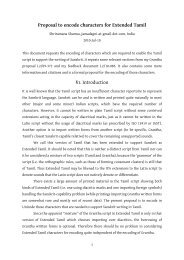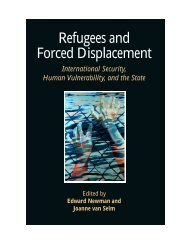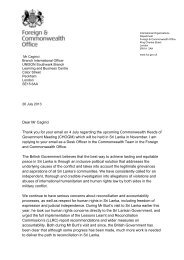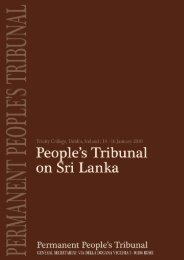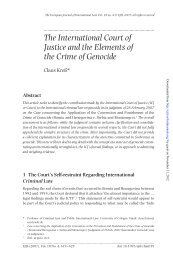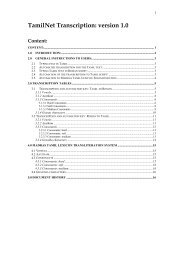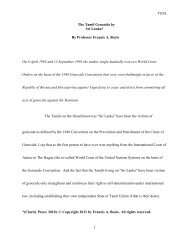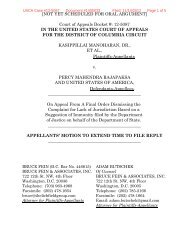Untitled - International Commission of Jurists
Untitled - International Commission of Jurists
Untitled - International Commission of Jurists
Create successful ePaper yourself
Turn your PDF publications into a flip-book with our unique Google optimized e-Paper software.
police investigations had taken place, with all <strong>of</strong> their manifest deficiencies.<br />
Subsequent to the recommendations in the 1994 Disappearances <strong>Commission</strong>s<br />
Reports, a special unit within the CID (the Disappearances Investigation Unit (DIU))<br />
had been put in charge <strong>of</strong> investigations but their performance had not been<br />
satisfactory, as seen above. Indeed, as noted, when <strong>of</strong>ficers heading the DIU<br />
attempted to perform their duties efficiently and proceeded to investigate senior<br />
<strong>of</strong>ficers’ consequent to the findings <strong>of</strong> the Disappearances <strong>Commission</strong>s, they were<br />
transferred out. 462<br />
2.2. Prosecutorial Discretion<br />
The lack <strong>of</strong> prosecutorial will in regard to prosecutions <strong>of</strong> enforced disappearances<br />
and extrajudicial killings 463 is part <strong>of</strong> a general context <strong>of</strong> an unsatisfactory<br />
prosecutorial record in respect <strong>of</strong> grave crimes 464 as well as in regard to ‘ordinary’<br />
torture cases. 465<br />
Ins<strong>of</strong>ar as cases <strong>of</strong> enforced disappearances and extrajudicial killings are concerned,<br />
the current procedure is that the police prosecute at the non-summary stage, with state<br />
counsel appearing only in rare cases judged to be <strong>of</strong> special significance. This practice<br />
is extremely unsatisfactory, particularly in the cases <strong>of</strong> crimes under international law,<br />
including torture and other ill-treatment, extrajudicial killings, including in mass<br />
numbers, and enforced disappearances which directly involve the police or the army<br />
as perpetrators.<br />
Thus, for example, human rights monitors expressed concern that in the<br />
Kumarapuram Case, evidence in the non-summary inquiry was led by an Inspector <strong>of</strong><br />
Police from the Mutur police station instead <strong>of</strong> a state counsel from the Attorney<br />
General’s Department. 466 Generally, the non-summary inquiry proceeds at a<br />
lackadaisical pace, frequently taking a number <strong>of</strong> months, and the vital task <strong>of</strong><br />
gathering evidence and conducting good investigations is left entirely to the police,<br />
with no stringent supervision by the magistrate 467 or by the <strong>of</strong>ficers <strong>of</strong> the Attorney<br />
General.<br />
462 Interviews with former senior police <strong>of</strong>ficers, 21.06.2009<br />
463 Wijesuriya v. the State, [1973] 77 NLR 25, (Premawathie Manamperi Case) evidences a successful<br />
prosecution in the 1970s, during the first JVP insurrection where the Court <strong>of</strong> Criminal Appeal held<br />
that whether there was a period <strong>of</strong> combat during the incident or a state <strong>of</strong> actual war, in either case,<br />
there could be no justification for the shooting <strong>of</strong> a prisoner who was held in custody. In a situation<br />
such as that which existed on that date, a soldier subject to military law should remain the custodian <strong>of</strong><br />
the civil law and has the responsibility <strong>of</strong> the discharge <strong>of</strong> police duties in which process, he is as much<br />
subject to the civil law as the ordinary policeman. In more recent times, the two high pr<strong>of</strong>ile cases in<br />
which successful prosecutions were evidenced was in the Krishanthi Kumaraswamy case and the<br />
Embilipitiya case, all <strong>of</strong> which however were limited to the culpability <strong>of</strong> junior <strong>of</strong>ficers.<br />
464 The rate is 4 percent; Committee Appointed to Recommend Amendments to the Practice and<br />
Procedure in Investigations and Courts, “The Eradication <strong>of</strong> Laws Delays,” Final Report, 02.04.2004,<br />
(the Committee was headed by the incumbent Attorney General). See also, Asian Human Rights<br />
<strong>Commission</strong>, ‘State <strong>of</strong> Human Rights in Eleven Asian Nations’, Hong Kong, 2006, at p. 288.<br />
465 From the time that the Anti-Torture Act was enacted into law in 1994, no convictions for torture<br />
resulted up to 2004, for a period <strong>of</strong> ten years. Thereafter, only three convictions by the High Court have<br />
been manifested to date.<br />
466 Movement for Interracial Justice and Equality, ‘Kumarapuram Massacre and Legal Proceedings,’<br />
April 1997, at p. 2.<br />
467 Section 124 <strong>of</strong> the CCP whereby Magistrates are called upon to assist the conduct <strong>of</strong> an investigation<br />
by making and issuing appropriate orders and processes <strong>of</strong> court is not implemented in actual practice.<br />
132



